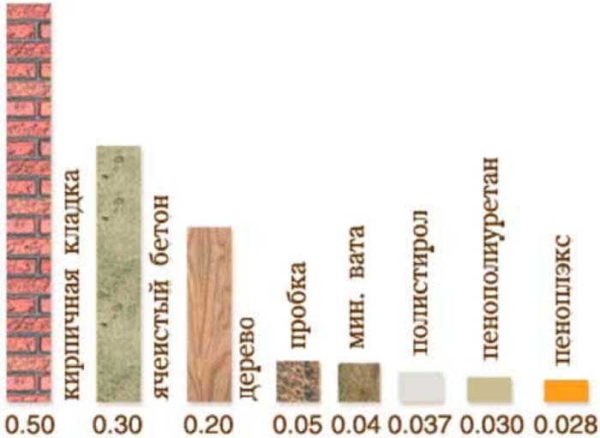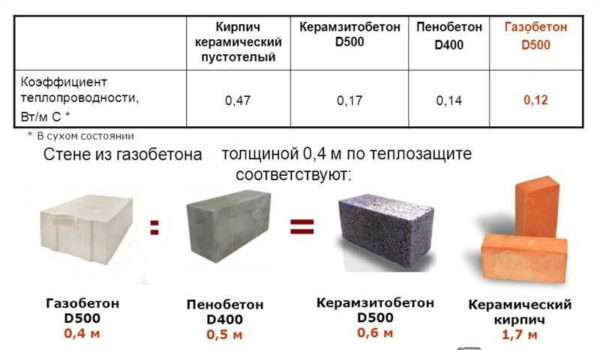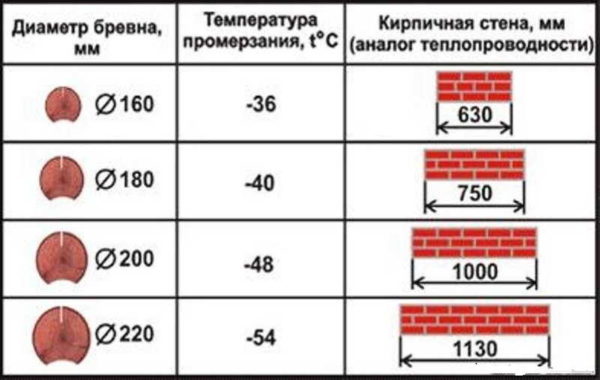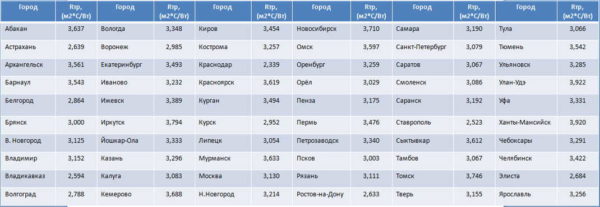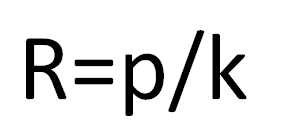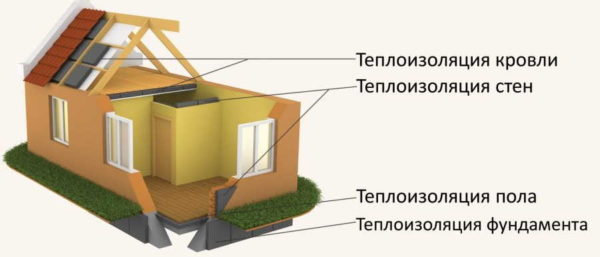Coefficient of thermal conductivity of materials
In recent years, when building a house or renovating it, much attention has been paid to energy efficiency. With already existing fuel prices, this is very important. Moreover, it seems that further savings will become increasingly important. To correctly select the composition and thickness of materials in the pie of enclosing structures (walls, floor, ceiling, roof), it is necessary to know the thermal conductivity of building materials. This characteristic is indicated on packages with materials, and it is necessary even at the design stage. After all, it is necessary to decide what material to build the walls from, how to insulate them, how thick each layer should be.
The content of the article
What is thermal conductivity and thermal resistance
When choosing building materials for construction, it is necessary to pay attention to the characteristics of the materials. One of the key positions is thermal conductivity. It is displayed by the thermal conductivity coefficient. This is the amount of heat that a particular material can conduct per unit of time. That is, the lower this coefficient, the worse the material conducts heat. Conversely, the higher the number, the better the heat dissipation.
Materials with low thermal conductivity are used for insulation, with high ones for transferring or removing heat. For example, radiators are made of aluminum, copper or steel, since they transfer heat well, that is, they have a high coefficient of thermal conductivity. For insulation, materials with a low coefficient of thermal conductivity are used - they retain heat better. If an object consists of several layers of material, its thermal conductivity is determined as the sum of the coefficients of all materials. When calculating, the thermal conductivity of each of the components of the "pie" is calculated, the values found are summed up. In general, we get the thermal insulation capacity of the enclosing structure (walls, floor, ceiling).
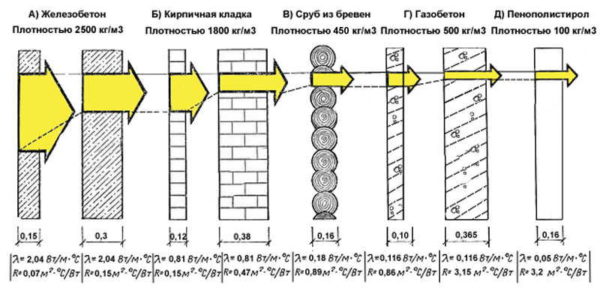
The thermal conductivity of building materials shows the amount of heat that it passes per unit of time.
There is also such a thing as thermal resistance. It reflects the ability of a material to prevent heat from passing through it. That is, it is the reciprocal of thermal conductivity. And, if you see a material with high thermal resistance, it can be used for thermal insulation. An example of thermal insulation materials is the popular mineral or basalt wool, polystyrene, etc. Materials with low thermal resistance are needed to dissipate or transfer heat. For example, aluminum or steel radiators are used for heating, as they give off heat well.
Thermal conductivity table of thermal insulation materials
To make it easier in the house to keep warm in winter and cool in summer, the thermal conductivity of the walls, floor and roof must be at least a certain figure, which is calculated for each region. The composition of the "pie" of the walls, floor and ceiling, the thickness of the materials are taken so that the total figure is not less (or better - at least a little more) recommended for your region.
When choosing materials, one should take into account that some of them (not all) conduct heat much better in conditions of high humidity. If during operation such a situation may arise for a long time, the calculations use thermal conductivity for this state.The thermal conductivity coefficients of the main materials used for insulation are shown in the table.
| Material name | Thermal conductivity coefficient W / (m ° C) | ||
|---|---|---|---|
| Dry | At normal humidity | With high humidity | |
| Woolen felt | 0,036-0,041 | 0,038-0,044 | 0,044-0,050 |
| Rock mineral wool 25-50 kg / m3 | 0,036 | 0,042 | 0,,045 |
| Rock mineral wool 40-60 kg / m3 | 0,035 | 0,041 | 0,044 |
| Rock mineral wool 80-125 kg / m3 | 0,036 | 0,042 | 0,045 |
| Rock mineral wool 140-175 kg / m3 | 0,037 | 0,043 | 0,0456 |
| Rock mineral wool 180 kg / m3 | 0,038 | 0,045 | 0,048 |
| Glass wool 15 kg / m3 | 0,046 | 0,049 | 0,055 |
| Glass wool 17 kg / m3 | 0,044 | 0,047 | 0,053 |
| Glass wool 20 kg / m3 | 0,04 | 0,043 | 0,048 |
| Glass wool 30 kg / m3 | 0,04 | 0,042 | 0,046 |
| Glass wool 35 kg / m3 | 0,039 | 0,041 | 0,046 |
| Glass wool 45 kg / m3 | 0,039 | 0,041 | 0,045 |
| Glass wool 60 kg / m3 | 0,038 | 0,040 | 0,045 |
| Glass wool 75 kg / m3 | 0,04 | 0,042 | 0,047 |
| Glass wool 85 kg / m3 | 0,044 | 0,046 | 0,050 |
| Expanded polystyrene (polystyrene, PPS) | 0,036-0,041 | 0,038-0,044 | 0,044-0,050 |
| Extruded polystyrene foam (EPS, XPS) | 0,029 | 0,030 | 0,031 |
| Foam concrete, aerated concrete on cement mortar, 600 kg / m3 | 0,14 | 0,22 | 0,26 |
| Foam concrete, aerated concrete on cement mortar, 400 kg / m3 | 0,11 | 0,14 | 0,15 |
| Foam concrete, aerated concrete on lime mortar, 600 kg / m3 | 0,15 | 0,28 | 0,34 |
| Foam concrete, aerated concrete on lime mortar, 400 kg / m3 | 0,13 | 0,22 | 0,28 |
| Foam glass, crumb, 100 - 150 kg / m3 | 0,043-0,06 | ||
| Foam glass, crumb, 151 - 200 kg / m3 | 0,06-0,063 | ||
| Foam glass, crumb, 201 - 250 kg / m3 | 0,066-0,073 | ||
| Foam glass, crumb, 251 - 400 kg / m3 | 0,085-0,1 | ||
| Foam block 100 - 120 kg / m3 | 0,043-0,045 | ||
| Foam block 121 - 170 kg / m3 | 0,05-0,062 | ||
| Foam block 171 - 220 kg / m3 | 0,057-0,063 | ||
| Foam block 221 - 270 kg / m3 | 0,073 | ||
| Ecowool | 0,037-0,042 | ||
| Polyurethane foam (PPU) 40 kg / m3 | 0,029 | 0,031 | 0,05 |
| Polyurethane foam (PPU) 60 kg / m3 | 0,035 | 0,036 | 0,041 |
| Polyurethane foam (PPU) 80 kg / m3 | 0,041 | 0,042 | 0,04 |
| Cross-linked polyethylene foam | 0,031-0,038 | ||
| Vacuum | 0 | ||
| Air + 27 ° C. 1 atm | 0,026 | ||
| Xenon | 0,0057 | ||
| Argon | 0,0177 | ||
| Airgel (Aspen aerogels) | 0,014-0,021 | ||
| Slag | 0,05 | ||
| Vermiculite | 0,064-0,074 | ||
| Foamed rubber | 0,033 | ||
| Cork sheets 220 kg / m3 | 0,035 | ||
| Cork sheets 260 kg / m3 | 0,05 | ||
| Basalt mats, canvas | 0,03-0,04 | ||
| Tow | 0,05 | ||
| Perlite, 200 kg / m3 | 0,05 | ||
| Expanded perlite, 100 kg / m3 | 0,06 | ||
| Linen insulating plates, 250 kg / m3 | 0,054 | ||
| Polystyrene concrete, 150-500 kg / m3 | 0,052-0,145 | ||
| Granular cork, 45 kg / m3 | 0,038 | ||
| Mineral cork on bitumen basis, 270-350 kg / m3 | 0,076-0,096 | ||
| Cork floor covering, 540 kg / m3 | 0,078 | ||
| Technical plug, 50 kg / m3 | 0,037 | ||
Some of the information is taken from standards that prescribe the characteristics of certain materials (SNiP 23-02-2003, SP 50.13330.2012, SNiP II-3-79 * (Appendix 2)). Those material that are not spelled out in the standards are found on the manufacturers' websites. Since there are no standards, they can vary significantly from manufacturer to manufacturer, so when buying, pay attention to the characteristics of each material you buy.
Thermal conductivity table of building materials
Walls, floors, floors can be made from different materials, but it so happened that the thermal conductivity of building materials is usually compared with brickwork. Everyone knows this material, it is easier to associate with it. The most popular are diagrams that clearly demonstrate the difference between different materials. There is one such picture in the previous paragraph, the second - a comparison of a brick wall and a wall of logs - is given below. That is why thermal insulation materials are chosen for walls made of bricks and other materials with high thermal conductivity. To make it easier to select, the thermal conductivity of the main building materials is tabulated.
| Material name, density | Coefficient of thermal conductivity | ||
|---|---|---|---|
| dry | at normal humidity | at high humidity | |
| CPR (cement-sand mortar) | 0,58 | 0,76 | 0,93 |
| Lime-sand mortar | 0,47 | 0,7 | 0,81 |
| Gypsum plaster | 0,25 | ||
| Foam concrete, aerated concrete on cement, 600 kg / m3 | 0,14 | 0,22 | 0,26 |
| Foam concrete, aerated concrete on cement, 800 kg / m3 | 0,21 | 0,33 | 0,37 |
| Foam concrete, aerated concrete on cement, 1000 kg / m3 | 0,29 | 0,38 | 0,43 |
| Foam concrete, aerated concrete on lime, 600 kg / m3 | 0,15 | 0,28 | 0,34 |
| Foam concrete, aerated concrete on lime, 800 kg / m3 | 0,23 | 0,39 | 0,45 |
| Foam concrete, aerated concrete on lime, 1000 kg / m3 | 0,31 | 0,48 | 0,55 |
| Window glass | 0,76 | ||
| Arbolit | 0,07-0,17 | ||
| Concrete with natural gravel, 2400 kg / m3 | 1,51 | ||
| Lightweight concrete with natural pumice, 500-1200 kg / m3 | 0,15-0,44 | ||
| Concrete on granulated slag, 1200-1800 kg / m3 | 0,35-0,58 | ||
| Boiler slag concrete, 1400 kg / m3 | 0,56 | ||
| Crushed stone concrete, 2200-2500 kg / m3 | 0,9-1,5 | ||
| Concrete on fuel slag, 1000-1800 kg / m3 | 0,3-0,7 | ||
| Porous ceramic block | 0,2 | ||
| Vermiculite concrete, 300-800 kg / m3 | 0,08-0,21 | ||
| Expanded clay concrete, 500 kg / m3 | 0,14 | ||
| Expanded clay concrete, 600 kg / m3 | 0,16 | ||
| Expanded clay concrete, 800 kg / m3 | 0,21 | ||
| Expanded clay concrete, 1000 kg / m3 | 0,27 | ||
| Expanded clay concrete, 1200 kg / m3 | 0,36 | ||
| Expanded clay concrete, 1400 kg / m3 | 0,47 | ||
| Expanded clay concrete, 1600 kg / m3 | 0,58 | ||
| Expanded clay concrete, 1800 kg / m3 | 0,66 | ||
| ladder made of solid ceramic bricks on the CPR | 0,56 | 0,7 | 0,81 |
| Ceramic hollow brick masonry on CPR, 1000 kg / m3) | 0,35 | 0,47 | 0,52 |
| Ceramic hollow brick masonry on the central control center, 1300 kg / m3) | 0,41 | 0,52 | 0,58 |
| Masonry of hollow ceramic bricks on the central construction site, 1400 kg / m3) | 0,47 | 0,58 | 0,64 |
| Solid sand-lime brick masonry on CPR, 1000 kg / m3) | 0,7 | 0,76 | 0,87 |
| Hollow sand-lime brick masonry on CPR, 11 voids | 0,64 | 0,7 | 0,81 |
| Hollow sand-lime brick masonry on CPR, 14 voids | 0,52 | 0,64 | 0,76 |
| Limestone 1400 kg / m3 | 0,49 | 0,56 | 0,58 |
| Limestone 1 + 600 kg / m3 | 0,58 | 0,73 | 0,81 |
| Limestone 1800 kg / m3 | 0,7 | 0,93 | 1,05 |
| Limestone 2000 kg / m3 | 0,93 | 1,16 | 1,28 |
| Building sand, 1600 kg / m3 | 0,35 | ||
| Granite | 3,49 | ||
| Marble | 2,91 | ||
| Expanded clay, gravel, 250 kg / m3 | 0,1 | 0,11 | 0,12 |
| Expanded clay, gravel, 300 kg / m3 | 0,108 | 0,12 | 0,13 |
| Expanded clay, gravel, 350 kg / m3 | 0,115-0,12 | 0,125 | 0,14 |
| Expanded clay, gravel, 400 kg / m3 | 0,12 | 0,13 | 0,145 |
| Expanded clay, gravel, 450 kg / m3 | 0,13 | 0,14 | 0,155 |
| Expanded clay, gravel, 500 kg / m3 | 0,14 | 0,15 | 0,165 |
| Expanded clay, gravel, 600 kg / m3 | 0,14 | 0,17 | 0,19 |
| Expanded clay, gravel, 800 kg / m3 | 0,18 | ||
| Gypsum boards, 1100 kg / m3 | 0,35 | 0,50 | 0,56 |
| Gypsum boards, 1350 kg / m3 | 0,23 | 0,35 | 0,41 |
| Clay, 1600-2900 kg / m3 | 0,7-0,9 | ||
| Refractory clay, 1800 kg / m3 | 1,4 | ||
| Expanded clay, 200-800 kg / m3 | 0,1-0,18 | ||
| Expanded clay concrete on quartz sand with porization, 800-1200 kg / m3 | 0,23-0,41 | ||
| Expanded clay concrete, 500-1800 kg / m3 | 0,16-0,66 | ||
| Expanded clay concrete on perlite sand, 800-1000 kg / m3 | 0,22-0,28 | ||
| Clinker bricks, 1800 - 2000 kg / m3 | 0,8-0,16 | ||
| Ceramic facing bricks, 1800 kg / m3 | 0,93 | ||
| Medium density rubble masonry, 2000 kg / m3 | 1,35 | ||
| Plasterboard sheets, 800 kg / m3 | 0,15 | 0,19 | 0,21 |
| Plasterboard sheets, 1050 kg / m3 | 0,15 | 0,34 | 0,36 |
| Plywood, glued | 0,12 | 0,15 | 0,18 |
| Fiberboard, chipboard, 200 kg / m3 | 0,06 | 0,07 | 0,08 |
| Fiberboard, chipboard, 400 kg / m3 | 0,08 | 0,11 | 0,13 |
| Fiberboard, chipboard, 600 kg / m3 | 0,11 | 0,13 | 0,16 |
| Fiberboard, chipboard, 800 kg / m3 | 0,13 | 0,19 | 0,23 |
| Fiberboard, chipboard, 1000 kg / m3 | 0,15 | 0,23 | 0,29 |
| Linoleum PVC on a heat-insulating basis, 1600 kg / m3 | 0,33 | ||
| Linoleum PVC on a heat-insulating basis, 1800 kg / m3 | 0,38 | ||
| PVC linoleum on a fabric basis, 1400 kg / m3 | 0,2 | 0,29 | 0,29 |
| PVC linoleum on a fabric basis, 1600 kg / m3 | 0,29 | 0,35 | 0,35 |
| PVC linoleum on a fabric basis, 1800 kg / m3 | 0,35 | ||
| Asbestos-cement flat sheets, 1600-1800 kg / m3 | 0,23-0,35 | ||
| Carpet, 630 kg / m3 | 0,2 | ||
| Polycarbonate (sheets), 1200 kg / m3 | 0,16 | ||
| Polystyrene concrete, 200-500 kg / m3 | 0,075-0,085 | ||
| Shell rock, 1000-1800 kg / m3 | 0,27-0,63 | ||
| Fiberglass, 1800 kg / m3 | 0,23 | ||
| Concrete tiles, 2100 kg / m3 | 1,1 | ||
| Ceramic tile, 1900 kg / m3 | 0,85 | ||
| PVC roof tiles, 2000 kg / m3 | 0,85 | ||
| Lime plaster, 1600 kg / m3 | 0,7 | ||
| Cement-sand plaster, 1800 kg / m3 | 1,2 | ||
Wood is one of the building materials with a relatively low thermal conductivity. The table provides indicative data for different breeds. When buying, be sure to look at the density and thermal conductivity. Not all of them are the same as prescribed in regulatory documents.
| Name | Coefficient of thermal conductivity | ||
|---|---|---|---|
| Dry | At normal humidity | With high humidity | |
| Pine, spruce across the grain | 0,09 | 0,14 | 0,18 |
| Pine, spruce along the grain | 0,18 | 0,29 | 0,35 |
| Oak along the grain | 0,23 | 0,35 | 0,41 |
| Oak across the grain | 0,10 | 0,18 | 0,23 |
| Cork tree | 0,035 | ||
| Birch tree | 0,15 | ||
| Cedar | 0,095 | ||
| Natural rubber | 0,18 | ||
| Maple | 0,19 | ||
| Linden (15% moisture) | 0,15 | ||
| Larch | 0,13 | ||
| Sawdust | 0,07-0,093 | ||
| Tow | 0,05 | ||
| Oak parquet | 0,42 | ||
| Piece parquet | 0,23 | ||
| Panel parquet | 0,17 | ||
| Fir | 0,1-0,26 | ||
| Poplar | 0,17 | ||
Metals conduct heat very well. They are often the cold bridge in the structure. And this must also be taken into account, to exclude direct contact by using heat-insulating layers and gaskets, which are called thermal break. The thermal conductivity of metals is summarized in another table.
| Name | Coefficient of thermal conductivity | Name | Coefficient of thermal conductivity | |
|---|---|---|---|---|
| Bronze | 22-105 | Aluminum | 202-236 | |
| Copper | 282-390 | Brass | 97-111 | |
| Silver | 429 | Iron | 92 | |
| Tin | 67 | Steel | 47 | |
| Gold | 318 |
How to calculate wall thickness
In order for the house to be warm in winter and cool in summer, it is necessary that the enclosing structures (walls, floor, ceiling / roof) must have a certain thermal resistance. This value is different for each region. It depends on the average temperatures and humidity in a particular area.
In order for heating bills to be not too large, building materials and their thickness must be selected so that their total thermal resistance is not less than that indicated in the table.
Calculation of wall thickness, insulation thickness, finishing layers
For modern construction, a situation is typical when the wall has several layers. In addition to the supporting structure, there is insulation, finishing materials. Each of the layers has its own thickness.How to determine the thickness of the insulation? The calculation is simple. Based on the formula:
R is thermal resistance;
p is the layer thickness in meters;
k - coefficient of thermal conductivity.
First, you need to decide on the materials that you will use in the construction. Moreover, you need to know exactly what kind of wall material, insulation, decoration, etc. After all, each of them makes its own contribution to thermal insulation, and the thermal conductivity of building materials is taken into account in the calculation.
First, the thermal resistance of the structural material is considered (from which the wall, floor, etc. will be built), then the thickness of the selected insulation is selected "according to the residual" principle. You can also take into account the thermal insulation characteristics of finishing materials, but usually they are a "plus" to the main ones. This is how a certain stock is laid "just in case." This reserve allows you to save on heating, which subsequently has a positive effect on the budget.
An example of calculating the thickness of insulation
Let's take an example. We are going to build a wall of bricks - one and a half bricks, we will insulate with mineral wool. According to the table, the thermal resistance of the walls for the region should be at least 3.5. The calculation for this situation is shown below.
- First, let's calculate the thermal resistance of the brick wall. One and a half bricks is 38 cm or 0.38 meters, the thermal conductivity of brick masonry is 0.56. We count using the above formula: 0.38 / 0.56 = 0.68. A wall of 1.5 bricks has such thermal resistance.
- We subtract this value from the total thermal resistance for the region: 3.5-0.68 = 2.82. This value must be "picked up" by thermal insulation and finishing materials.
- We consider the thickness of the mineral wool. Its thermal conductivity coefficient is 0.045. The thickness of the layer will be: 2.82 * 0.045 = 0.1269 m or 12.7 cm.That is, in order to provide the required level of insulation, the thickness of the mineral wool layer must be at least 13 cm.
If the budget is limited, you can take 10 cm of mineral wool, and the missing one will be covered with finishing materials. They will be inside and out. But, if you want the heating bills to be minimal, it is better to start up finishing with a "plus" to the calculated value. This is your reserve for the time of the lowest temperatures, since the norms of thermal resistance for building envelopes are calculated based on the average temperature over several years, and winters are abnormally cold. Therefore, the thermal conductivity of the building materials used for decoration is simply not taken into account.

